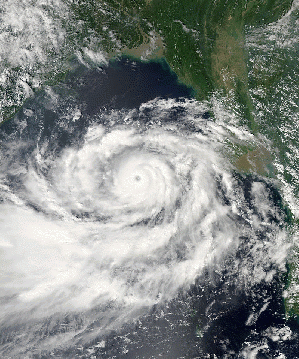It is convenient to regard disasters as acts of God. Even in this day and age, this fatalism appears sensible to a large number of people. After all, striving hard to ensure that nothing (i.e. no disaster) happens is certainly less eye-catching than making heroic efforts to contain damage after a disaster happens. Ironically, it is almost equally convenient to treat the Kashmir disaster as a manifestation of climate change. It shifts the attention to a wide range of local and global factors that have been active over a long period of time and makes pinpointing responsibility and ensuring accountability a difficult exercise. Again, like fatalism, this line of thought is likely to win a large number of followers among the growing tribe of factually well-informed environmentalists.
From the perspective of disaster risk management, there is no convenient way of shifting the focus away from what is, unambiguously, the most disturbing aspect of Kashmir disaster: the failure -- in fact, non-existence -- of early warning systems and negligible disaster preparedness. Accessible reports suggest that all the required technical inputs for early warning were available well on time but in the vast web of bureaucracy, absolutely no node was assigned the duty to act on those inputs. And, as environmentalists have rightly pointed out, the magnitude of the disaster was multiplied multifold by the accumulation of environmental damage caused by years of unsustainable development practices.
Kashmir disaster comes at a time when the world is discussing the new paradigm of disaster risk management for the post-2015 period. This will succeed the existing Hyogo Framework for Action (HFA 2005-2015) which is endorsed by 168 nations. The post-2015 framework is expected to be finalized at the UN World Conference on Disaster Risk Reduction in March 2015. HFA marked a significant progress in disaster risk management as it was based on a paradigm shift: from an emergency response to a more proactive approach aimed at reduction of disaster risk. Ongoing discussions indicate that the post-2015 framework is expected to be based on an even more proactive paradigm that focuses on avoidance of disaster risk construction and accumulation.
Speaking in terms of different paradigms of disaster risk management that have evolved over the years, Kashmir disaster is clearly a failure at the most basic level. The more advanced levels of disaster risk reduction or avoidance of disaster risk accumulation do not make much sense when even a primitive early warning system is not in place. The inept handling of Kashmir Floods gives the impression that India has made little progress in disaster risk management. This is reflected in the world media coverage of Kashmir floods as "predictable tragedy" (The Economist) or "preventable disaster" (New York Times).
But this is a grossly incorrect assessment of India's expertise in handling disasters. Available evidence hints at considerable progress in disaster preparedness and disaster risk reduction initiatives in India. This was evident in India's response to Cyclone Phailin last year. We may recall that it was marked by sophisticated early warning systems and well-orchestrated action plans which led to minimal loss of lives and earned world-wide praise for India's disaster risk management efforts. Comparison with a similar cyclone -- Cyclone 05B of 1999 in the same region -- clearly showed that the handling of Cyclone Phailin was almost flawless. And it was not just a short-term emergency operation; credible progress had also been made towards long-term plans aimed at reduction of disaster risk. It made one believe that India had indeed become well-equipped to handle disasters. Was it the same India that the world today has dismissed as a laggard that cannot avert even predictable disasters? Which paradigm of disaster risk management can explain the coexistence of response to Cyclone Phailin (2013) with the response to Kashmir Floods (2014)?

Cyclone Phailin Oct 10 2013
(Image by (From Wikimedia) NASA, MODIS/ LANCE, Author: NASA, MODIS/ LANCE) Details Source DMCA
The sense of dej vu is unmistakable here. The disparity in disaster response falls in line with the general pattern of disparities that characterize India's development process: coexistence of pockets of excellence with abject failure at meeting even the most basic requirements. For example, India has mastered advanced space technology but it has yet to succeed in providing safe drinking water to a large section of the population. These disparities, as decades of development experience indicates, tend to have deep roots that are tough to eliminate. That, unfortunately, comes with a grim corollary: if the disparity in disaster response is indeed a part of the general development pattern, then establishing a reliable disaster risk management system is going to be an arduous task.
Intriguingly, detailed and otherwise comprehensive discussions on the HFA and its successor have not focused on the issue of disparities in tackling disasters. The same nation may show widely different levels of preparedness, skills and maturity in handling different disasters. Hence, different levels of development in disaster risk management may coexist simultaneously. This may not be true for developed countries but this is the most probable scenario for developing countries like India where development process typically comes with such in-built disparities. Puzzling as they are, these disparities can often be devastating, as the experience of Kashmir floods demonstrates mercilessly. Still, the issue of disparities in responding to disasters does not seem to get the attention it deserves. And that is even more puzzling.




